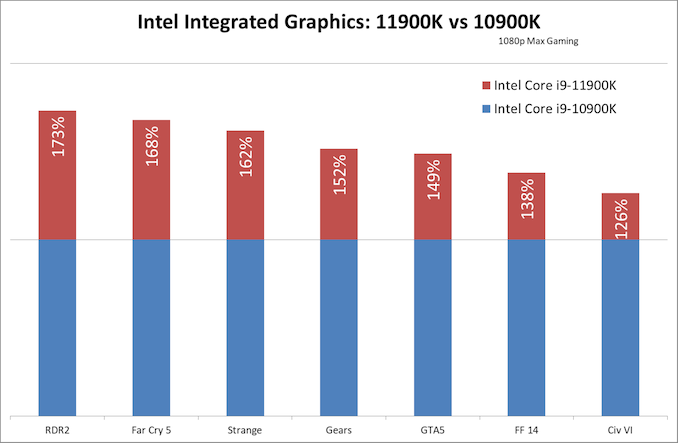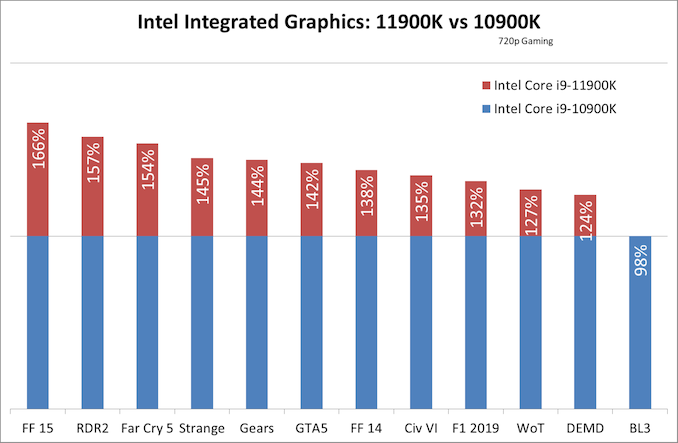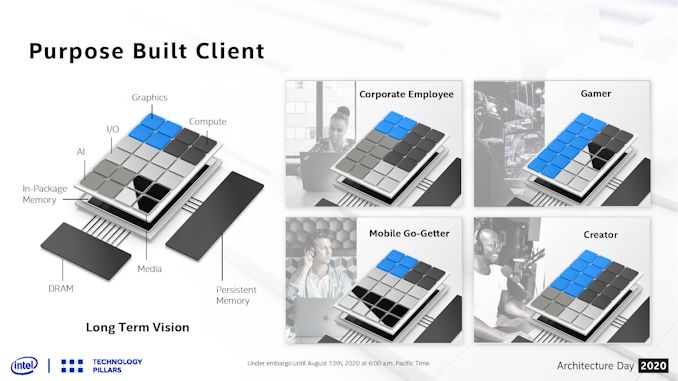Intel’s Integrated Graphics Mini-Review: Is Rocket Lake Core 11th Gen Competitive?
by Dr. Ian Cutress on May 7, 2021 10:20 AM ESTConclusions
No-one ever said that integrated graphics solutions had to be good. Nonetheless there is always the desire for something better, something higher performance, and something suitable for end-users. At the beginning of the era of integrated graphics, the focus was on simply providing something basic for 2D work - applications on an operating system and no real graphics rendering to mention. That solution is simple enough, however the demand on integrated graphics has grown over time, especially as the demands we put on our devices have also grown.
A modern system, especially a commercial system or one designed for work, has to do it all. Anyone not working in graphics might depend on a integrated solution to navigate complex arty web interfaces for the tool they use, or rely upon the acceleration features now baked into those platforms. Also perhaps, from time to time, some mild gaming use as well, if not outright using the compute features of the graphics for transcoding or AI. These demands are most heavily focused on mobile platforms, and as a result mobile platforms from Intel tend to get the best integrated graphics solutions, especially in thin-and-light designs where a discrete graphics solution is too power hungry. Intel's mobile Tiger Lake-U series offers a sizeable 96 execution units of the latest generation graphics architecture, compared to the desktop processors we are testing today, that only have 32.
So what use is a desktop processor with integrated graphics?
AMD and Intel both have product lines with integrated graphics. From Intel, its integrated graphics is in almost everything that Intel sells for consumers. AMD used to be that way in the mid-2010s, until it launched Ryzen, and now we have separate CPU-only and CPU+Graphics options. This is where the company philosophy differs.
AMD's desktop processors with integrated graphics are primarily intended to be a whole system replacement, with users relying on the integrated graphics for all their graphics needs. As a result AMD puts a lot more processing hardware into its integrated graphics solutions for the desktop, and it results in a good gaming experience for entry level gaming.
Intel's route on the otherhand is a bit more basic. The desktop integrated graphics here has two main directions: first, as the basic graphics needed for an office system, or second, more of a fall-back option for when the discrete card doesn't work or fails in more premium desktop systems. The power isn't there for hardcore grunt like gaming of any serious note, but it is certainly enough to cover the basics.
Despite this, with the new Xe-LP graphics solution, Intel has some aces up its sleeve. First is AV1 decoding, which allows users to watch AV1 content without putting stress on the CPU. Second is video encoding accelerationt through QuickSync, which has actually been a part of Intel's graphics for a number of years. Third is a relatively new feature: Intel's 'additional processor' mentality. Normally when a system has a discrete graphics card, the integrated graphics is disabled. But now, with its latest mobile devices for example, when Intel pairs its mobile processor with integrated graphics with a second graphics solution at about the same performance, with the right software Intel allows both graphics to work asynchrouusly on two different problems. The limit to this in the past has been dictating which graphics is the video out rather than simply a compute accelerator, but Intel believes it has worked it out. However, this is relatively little use for gaming, the topic of today.
Results Summary
In this review, we highlighted that Intel has now implemented its new Xe-LP graphics architecture onto its desktop processor line, and tested the new solutions against our traditional CPU gaming test suite. What we saw, in terms of a generational uplift from the i9-10900K to the i9-11900K, is actually quite impressive:
In our 720p testing, there's a clear generational gain across the board for Rocket Lake, and in most cases the games become a lot more playable. The average gain is 39%. If we flip to our gaming results at the higher resolution and settings:

Games with under 10 FPS across the board are left out
For these titles, the average gain is 153%, showing that Xe-LP is certainly a step up regardless of the workload.
The Future of Integrated Graphics
A key talking point about integrated graphics is whether a company should leverage a strong CPU product at the expense of graphics, or aim for something with strong integrated graphics as a more complete chip at the expense of the mid-range graphics market. The console market for example relies fully on integrated graphics designs, especially as it keeps the manufacturing simpler and number of chips lower. But on the desktop space, because discrete graphics are an option (well, when we're not in a mining craze or semiconductor shortage), there seems to be no impetus for companies to do a full fat integrated graphics solution that competes on the same stage as a mid-range graphics card. AMD could do it, but it might overlap with their console agreements, and Intel hasn't done anything serious since Broadwell.
To put a nod to Broadwell, Intel's 5th Gen processor. It was so powerful at integrated graphics at the time, we are still using it today as a comparison point when comparing against other Intel solutions. Broadwell had dedicated 48% of the die area of its top processor to graphics, and for that product it also added some really fast cache memory as well. Intel's focus on integrated graphics as a function of die size has decreased over time, now with Rocket Lake sits at around 20% of the silicon. It hasn't been this low since Intel first introduced its integrated graphics solutions. For that 20%, we get 32 execution units with eight processing cores. Tiger Lake has 96 EUs which total around 33% of overall die size, but has four cores. If Intel was focused on graphics performance in the same way as it was in Broadwell, we might be looking at a 256+ EU solution.
With Intel taking a renewed approach to graphics with its Xe portfolio, stemming from entry up to high performance compute, there is room here for Intel to develop integrated graphics focused solutions. Intel has detailed that it is moving to chiplets with its future mainstream processors under its 'Client 2.0' strategy, and part of that is allowing customers to select how many IP blocks they want of cores, IO, memory, security, and graphics. In the image above, the Gamer option has half of the die area for graphics. This could at the end of the day be a target that could see Intel making desktop integrated graphics a focus again.












165 Comments
View All Comments
Spunjji - Monday, May 10, 2021 - link
"Why is the 4750g even in the list if you can't BUILD with it?"Because you can buy it, duh.
"blah blah blah, rabble rabble, I know better than Lisa Su, whine piss moan"
Nobody cares what you think. AMD had excellent financial results last quarter -especially for Q1 - and you were conspicuously absent from the comments there.
https://www.anandtech.com/show/16645/amd-reports-q...
mode_13h - Tuesday, May 11, 2021 - link
> and you were conspicuously absent from the comments there.SHHHHhhhhh!!
watzupken - Saturday, May 8, 2021 - link
"Conclusion: Let's hope Intel gives Alder Lake at least 96 EU Xe graphics as iGPU; as things look right now, dGPUs will remain unaffordable or downright unobtainable. Otherwise, it's back to 10 fps as standard"Don't want to burst your bubble, but the odds of seeing a 96 EU XE graphics on desktop Alder Lake is quite slim. The fact that Intel have adamently stick to 8 performance cores and not more is likely due to constrains in die size and/or power. Moreover, you can tell that Intel's strategy with iGPU is unlike AMD. At least from what we observed, AMD's APU strives to provide a cheap gaming experience, unless you choose to go with the Athlon series. Intel on the other hand is just provide their users with an iGPU for display purpose and almost no focus on making it gaming worthy. In my opinion, both approach makes sense, i.e. no right or wrong. I do feel Intel's approach sound more logical to me because it doesn't make sense for a gamer to spend so much on an APU that can only game at 1080p at low frame rates.
Fulljack - Tuesday, May 11, 2021 - link
because AMD APUs are mainly aimed for esport titles. where games doesn't the greatest and the bestest chip to run at 1080p@60fps using low settings. this is where internet cafe in Asia thrive, which is exactly where AMD APUs will end up to, at OEM pre-built PC.it's a matter of perspective—it doesn't makes sense for PC builder, it makes sense if you have tight budget.
GeoffreyA - Wednesday, May 12, 2021 - link
"it makes sense if you have tight budget"Fantastic for those on a budget, at least when Raven Ridge and Picasso were priced within the realms of reason. It's a graphics card for free.
scineram - Saturday, May 8, 2021 - link
Rembrandt will begin a new era for sure.vol.2 - Saturday, May 8, 2021 - link
The issue isn't 20FPS VS 60FPS (for me), it's the minimum FR. If it dips below 15, or it swings more than 15FPS in anything lower than 60FPS, I feel sick. We should be paying attention to minimum FPS over 15FPS, and measuring frame swing.Jon Tseng - Saturday, May 8, 2021 - link
So one thing I never get is why Intel don't do high end SKUs without the IGPU. I mean Ryzen has the node advantage and all that, but another thing people don't talk about is they don't need to burn nearly a quarter of the die area on graphics. That would actually give Intel space for a material increase in core-count which is exactly the area where they are massively lagging.I guess it is something to do with the tape-out cost - but how hard can it be to fuse off the GPU I/O and lay down some more CPU cores down? Especially given how much they are losing in HEDT sales + halo effect by being uncompetitive.
Mystery to me anyhow. Seems something of a no-brainer, tape-out costs aside.. ¯\_(ツ)_/¯
KAlmquist - Saturday, May 8, 2021 - link
The article says that the IGPU occupies about 20% of the die area, so a chip with 10 cores and no IGPU would be about the same size as their current 8 core chip. I don't think Intel has done variants that are that close in core counts in the past. We've seen similar behavior from AMD, which (for example) decided to do a chip with 2 Zen CCX (8 cores), and a chip with on Zen CCX (4 cores) and an IGPU, but not a chip with 1 Zen CCX but no IGPU. I suspect the explanation is the one you suggest: tape-out costs must be really high.mode_13h - Sunday, May 9, 2021 - link
> why Intel don't do high end SKUs without the IGPUThey do. They have a whole line of HEDT and workstation CPUs with up to 18 cores and no iGPU.